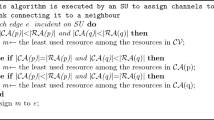Abstract
With the advent of smarter technologies in LTE, often the bands used for lower technologies remain unoccupied in cellular networks (CN). To utilize those, in this paper, a new paradigm of cognitive radio has been proposed for IoT, where the nodes of a self-organized opportunistic ad hoc network, act as the secondary users (SU) to use the white spaces of the co-existing cellular network. Each SU of the ad hoc network, in a self-organized fashion, collaborates with other SUs to reduce the impact of cognitive users on the primary network and also to improve the performance of the ad hoc network. Since it does not require the control of the core network, the device to device communication proposed in 5G CN, also can apply this technique for sharing the cellular spectrum without the control of the core network. We have developed distributed algorithms for cooperative channel sharing to reduce the spectrum latency as well as to improve the channel utilization. The proposed algorithms not only improve the system performance in offloading the traffic but also reduce the control overhead of the backbone network. Simulation results show that the proposed cooperative techniques perform better in terms of channel utilization, energy-efficiency, and call block/drop rate with respect to other cooperative approaches with insignificant additional message overhead at users’ end.
















Similar content being viewed by others
References
Brydon, A. (2014, February 28) Opportunities and threats from LTE device-to-device (D2D) communication. Wireless Blog. http://www.unwiredinsight.com.
Lin, X., Andrews, J. G., Ghosh, A., & Ratasuk, R. (2014). An overview of 3g pp device-to-device proximity services. IEEE Communications Magazine, 52(4), 40–48.
Akyildiz, I. F., Lee, W., Vuran, M. C., & Mohanty, S. (2008). A survey on spectrum management in cognitive radio networks. IEEE Communications Magazine, 46(4), 40–48.
Salami, G., Durowoju, O., Attar, A., Holland, O., Tafazolli, R., & Aghvami, H. (2011). A comparison between the centralized and distributed approaches for spectrum management. In Communications surveys tutorials, (pp. 274–290; 2nd Edn.). IEEE
Das, A., Ghosh, S.C., Das, N., & Barman, A.D. (2015) Cooperative spectrum mobility in heterogeneous opportunistic networks using cognitive radio. In IEEE 40th conference on local computer networks (LCN) (pp. 402–405). IEEE.
Khanikar, K., Sinha, R., & Bhattacharjee, R. (2018). Cooperative spectrum sensing using quantized energy statistics in the absence of dedicated reporting channel. IEEE Transactions on Vehicular Technology, 99, 1-1.
Eryigit, S., Bayhan, S., Kangasharju, J., & Tugcu, T. (2015). Optimal cooperator set selection in social cognitive radio networks, IEEE Transactions on Vehicular Technology, 99, 1.
Zhou, F., Li, Z., Si, J., Hao, B., & Qi, P. (2015). Adaptive secondary-user selection without prior information for cooperative spectrum sensing in CRNS. In 2015 international conference on computer, information and telecommunication systems (CITS), (pp. 1–5).
Liu, X., Jia, M., Na, Z., Lu, W., & Li, F. (2018). Multi-modal cooperative spectrum sensing based on dempster-shafer fusion in 5g-based cognitive radio. IEEE Access, 6, 199–208.
Buddhikot, M. (2010). Cognitive radio, dsa and self-x: Towards next transformation in cellular networks. In 2010 IEEE symposium on new frontiers in dynamic spectrum (pp. 1–5).
Zhou, R., Zhang, Y., Sun, X., & Guo, C. (2017). A cooperative spectrum sensing algorithm based on Bayesian compressed sensing. In 3rd IEEE international conference on computer and communications (ICCC) (pp. 658–662).
Das, A., Ghosh, S. C., Das, N., & Barman, A. D. (2017). Q-learning based co-operative spectrum mobility in cognitive radio networks. In IEEE 42nd conference on local computer networks (LCN) (pp. 502–505).
Thakur, P., Kumar, A., Pandit, S., Singh, G., & Satashia, S. N. (Dec 2016) Performance improvement of cognitive radio network using spectrum prediction and monitoring techniques for spectrum mobility. In Fourth international conference on parallel, distributed and grid computing (PDGC), (pp. 679–684).
Das, A., & Das, N. (2019). Cooperative cognitive radio for wireless opportunistic networks. In 2019 11th international conference on communication systems & networks (COMSNETS), Bengaluru, India (pp. 574–576).
Tcha, D.-W., Kwon, J.-H., Choi, T.-J., & Oh, S.-H. (2000). Perturbation-minimizing frequency assignment in a changing tdma/fdma cellular environment. IEEE Transactions on Vehicular Technology, 49(2), 390–396.
Čabrić, D., Mishra, S.M., Willkomm, D., Brodersen, R., & Wolisz, A. (2005). A cognitive radio approach for usage of virtual unlicensed spectrum In 14th IST mobile and wireless communications summit.
Han, C., Wang, J., Yang, Y., & Li, S. (2008). Addressing the control channel design problem: Ofdm-based transform domain communication system in cognitive radio. Computer Networks, 52(4), 795–815.
Salameh, H. B., Krunz, M., & Younis, O. (2009). Mac protocol for opportunistic cognitive radio networks with soft guarantees. IEEE Transactions on Mobile Computing, 8(10), 1339–1352.
Chen, T., Zhang, H., Katz, M.D., & Zhou, Z. (2008) Swarm intelligence based dynamic control channel assignment in cogmesh. In Communications Workshops, 2008. ICC Workshops’ 08. IEEE International Conference on. IEEE, (pp. 123–128).
Chen, T., Zhang, H., Maggio, G.M., & Chlamtac, I. (2007) Cogmesh: A cluster-based cognitive radio network. In 2nd IEEE international symposium on new frontiers in dynamic spectrum access networks, 2007. DySPAN 2007. IEEE, pp. 168–178.
Ghosh, S. C., Sinha, B. P., & Das, N. (2006). Coalesced cap: an improved technique for frequency assignment in cellular networks. IEEE Transactions on Vehicular Technology, 55(2), 640–653.
Lee, W., & Cho, D. H. (2013). New cooperation-based channel state acquisition scheme for ad hoc cognitive radio systems. IEEE Transactions on Vehicular Technology, 62(7), 3325–3338.
Verma, R., & Saini, G. (2016) Statistical tuning of cost-231 hata model at 1.8 ghz over dense urban areas of ghaziabad. In 3rd international conference on computing for sustainable global development (INDIACom) (pp. 1220–1225).
Acknowledgements
The work is undertaken as part of Information Technology Research Academy (ITRA), Media Lab Asia project entitled Mobile Broadband Service Support over Cognitive Radio Networks.
Author information
Authors and Affiliations
Corresponding author
Additional information
Publisher's Note
Springer Nature remains neutral with regard to jurisdictional claims in published maps and institutional affiliations.
Rights and permissions
About this article
Cite this article
Das, A., Ghosh, S.C., Das, N. et al. Cooperative Spectrum Mobility in Heterogeneous Opportunistic Networks for IoT. Wireless Pers Commun 110, 2065–2085 (2020). https://doi.org/10.1007/s11277-019-06830-z
Published:
Issue Date:
DOI: https://doi.org/10.1007/s11277-019-06830-z




